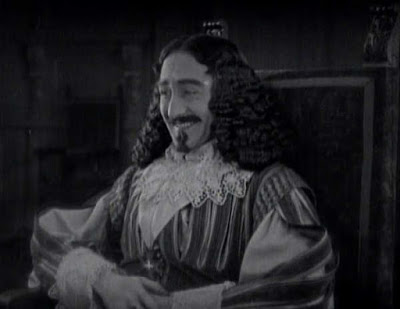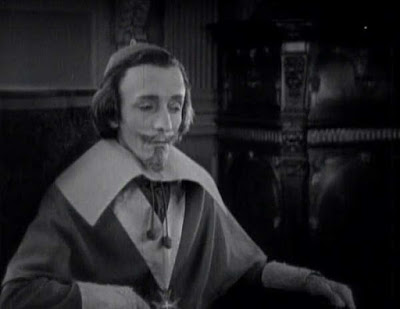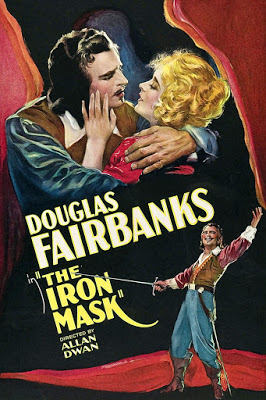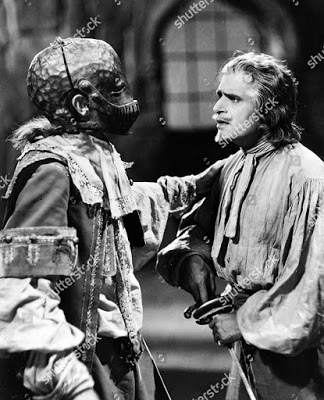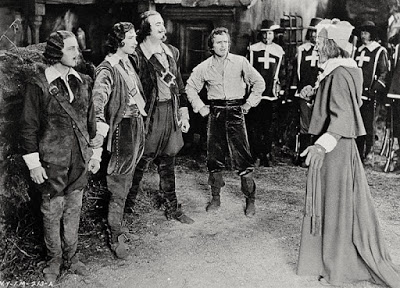Douglas Fairbanks
as D'Artignan
A Modern Musketeer
Director: Allan Dwan
Year: 1917
Rating: 6.0

This was made a few years before Douglas Fairbanks entered into his classic
swashbuckling phase with great stunts but it certainly strongly hints at what
is to come. It is directed by Allan Dwan who was later to direct Fairbanks
in Robin Hood and he is partially credited for convincing Fairbanks that he
could do these physical stunts. Fairbanks does some amazing feats here that
had me holding my breath. The guy had no fear. Why take the stairs when you
can simply climb the house much faster. Why walk when you can jump or somersault.
Why not do handstands next to a precipice hundreds of feet below. He is like
a kid with ADHD (attention deficit hyperactivity disorder). He never slows
down. The film gives an explanation for this which is slightly ludicrous
but this film begins as a comedy before it moves into drama, romance and
adventure.
His mother is a big reader of Alexander Dumas and wants her expectant son
to be like D'Artagnan. He is also born during a Kansas cyclone made famous
years later in another film. The film for no particular reason has his mother
imagining her son as D'Artagnan in a scene rescuing the handkerchief of a
lady from a group of ruffians. In 1921 Fairbanks actually plays D'Artignan
in The Three Musketeers but for now it is just a dream. When he has grown-up
Kansas is too small for him and he gets his parent's permission to leave -
when they give it to him he celebrates by climbing a church and then the spire
and hanging from it. Look for Zazu Pitts as a girl in the town.
He gets in his car and leaves but soon runs into a car that is stuck because
of a big earth collapse. In this car are three people - a mother and daughter
and a man. The older man has received permission from the mother to seduce
her daughter. Ned (Fairbanks) devises a way to ride an abandoned railroad
track and gets them to the hotel. Apparently, a very famous hotel in real
life - the El Tovar Hotel in Arizona - which was added to the National Register
of Historic Places. The film was shot in the Canyon de Chelly National Monument,
which is an astonishingly rugged and beautiful place. The second part of the
film kicks in when an outlaw kidnaps the young girl and the man and Fairbanks
has to rescue them from a deserted pueblo mountain side.
This was quite good - the video is in perfect shape - the photography is
great and though Fairbanks can admittedly get annoying with his high spirits
he is an incredible athlete. And really doesn't look like one at all. The
girl is played by Marjorie Daw who was fifteen at the time. She later married
Myron Selznick (brother of producer David Selznick) and after that she married
director A. Edward Sutherland. She is very cute and personable in this. At
one point she says I love your speaking voice. Which of course we never hear.
The Three Musketeers
Director: Fred Niblo
Year: 1921
Rating: 7.5
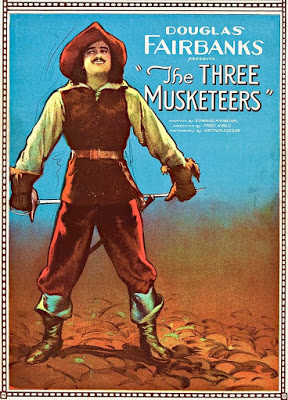
Douglas Fairbanks really ups his game from Zorro in this one. Zorro showed
a lot of his physical skills but was a little modest on the sets and budgets.
The Three Musketeers clearly threw in a lot of money on this one. Ornate sets,
great period design, a fine group of supporting actors and a reconstruction
of a Parisian neighborhood and palace circa 1625 with hundreds of extras walking
through the scenes. There had already been two feature films about the Musketeers
from Hollywood (others from France) but this is the one that set the standard
and to some degree the plot structure that future films would follow such
as the 1948 version with Gene Kelly. Dumas's book was very long - written
in serial form for a newspaper - with various interconnecting plots taking
place but this has become the best known condensed version of them. It is
a great adventure tale and the Musketeers are still icons in our time - even
having a candy bar named after them.
Watching Fairbanks on the screen is both exhilarating and cringeworthy.
When he is in movement he is so graceful and athletic making everything look
easy whether it is simply jumping on to a bench or climbing up a wall - but
his acting is really lacking in everything but high spirits or petulance.
And preening. Understanding of course that these are silent films but even
so his exaggerated expressions of joy or distress feel so overplayed for
our time but I would assume not for back then since he was enormously popular
all over the world. I have enjoyed watching his films recently but every time
I think just tone it down a bit. You don't have to jump in the air when you
see a pretty girl.
So the plot that became standard is here but I enjoyed that the film spends
a lot of time on the political intrigues that are occurring in the Court of
Louis XIII between him, Cardinal Richelieu, Queen Anne and from England the
Duke of Buckingham. In fact, the film begins with a chess game between the
Cardinal and the King in which Richelieu insinuates that the Queen is not
being faithful. Richelieu is concerned that the Queen has too much influence
with the King and so wants to destroy her reputation with various underhanded
plots. Within the Queen's attending ladies is Constance, her seamstress and
confidant and Milady de Winter, a spy for the Cardinal.
Into this political potboiler comes the innocent D'Artagnan from the province
of Gascon. From a once noble family now nearing poverty. His father sends
him off to Paris with the words "Fight. Fight everyone". Something D'Artagnan
takes to heart and soon has duels set up with three men he feels insulted
him - Athos, Porthos and Aramis - from the King's Musketeer Guards. But before
they can get down to exchanging sword blows the Cardinal Guards show up to
arrest them for fighting and D'Artagnan joins the Musketeers to fight them
off. From that point on they are One for All and All for One. Soon they have
to prove that by saving the Queen from Richelieu. Sword fights, horse rides
and romance to follow.
Directed by Fred Niblo who had directed the Mark of Zorro and Ben-Hur in
a few years. There are two names in the cast who went on to fine careers in
the talkies. The King is played by Adolphe Menjou and I still recall Bill
Maher on his show once saying "Menjou who? What is a Menjou?" and my respect
for him went down a few notches. And Aramis is none other than Eugene Pallette!
Pallette was to put on quite a bit of poundage by the Talkies and with his
unique froggy voice become one of the great comedic character actors in the
1930s and 40s. A Musketeer. Who would have thought it.
The Iron Mask
Director: Allan Dwan
Year: 1929
Rating: 6.5
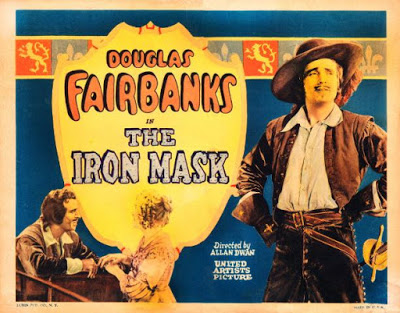
Eight years after Douglas Fairbanks The Three Musketeers, he returns with
a sequel that was based on the Dumas sequel to the Three Musketeers. There
were a bunch of them actually - Dumas wrote thousands of pages on their stories
- this one was a sub-plot within The Vicomte of Bragelonne - and has
come to be called The Man in the Iron Mask. A few of the actors return from
the previous film - Marguerite De La Motte as Constance, the love of D'Artignan,
Nigel De Brulier as Richelieu, Lon Poff as Father Joseph and Leon Bary as
Athos. My guess is Eugene Pallette had outgrown his role as Aramis - literally.
There is then the question of which version to watch. This was Fairbank's
last silent film though his transition to Talkies was not as successful as
his silent films but I am curious to see him in Robinson Crusoe (1932) and
The Private Life of Don Juan (1934). But this came out in 1929 when sound
had come to the movies. They added a sound prologue, a few speeches from Fairbanks
and a song - but these bits have been lost. This version I watched runs 100
minutes with intertitles but there are versions out there that run about
75 minutes. Then in 1950 a version was released with Douglas Fairbanks Jr.
narrating through the entire film. I started watching that one before I realized
it was the shorter version and after a while the narration describing what
we were seeing became irritating. And finally there is a color version out
there. I would recommend the original even with the lost soundtrack. All
up on YouTube.
It is a fine film - less spectacular than the Three Musketeers - but even
after all the many film versions of the story that were to come it is still
a great exciting story. In some film versions the son of the King that is
sent away is the good son and the son that becomes King is a tyrant. In this
case it is the opposite with the good son being replaced by the spoiled one
who resents having been sent away. This is closer to the book but in the book
it is Aramis who is behind this treachery! The film covers a lot of years.
It begins four years after the Three Musketeers and Louis XIII is still King,
Richelieu is still Cardinal, Queen Anne is still on the throne and the Musketeers
still friends.
The Queen has twin boys and Richelieu immediately recognizes the danger
of having two sons vying for the throne. 0ne has to go. This is not unusual
- in some ancient royal families the younger brothers were killed. So one
of the sons is sent away to be brought up not knowing who he was. Richelieu
assigns D'Artignan to be the boy who was to become King's bodyguard. Twenty-years
pass. Louis XIII has died, Richelieu has died and D'Artignan retires. And
forces move to remove King Louis XIV and replace him with the other son. D'Artignan
has to call for help. And who else but his three friends who have all retired
to the country. The final 25 minutes is terrific. Directed by Allan Dwan.









